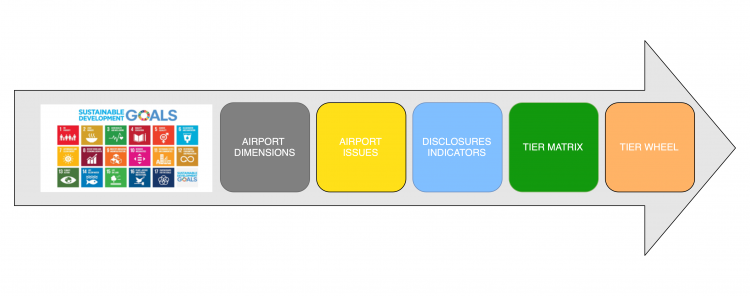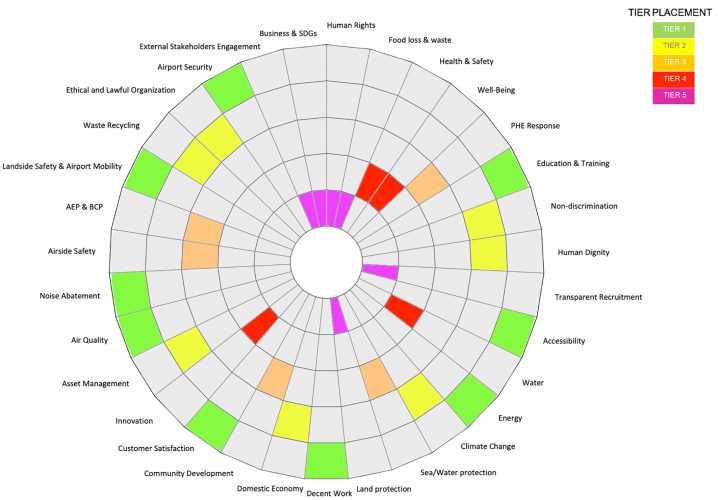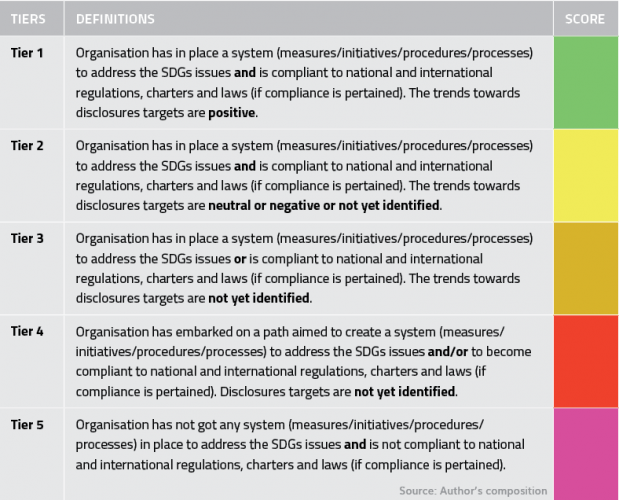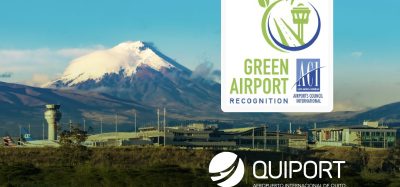Airports must evaluate their contribution to the UN Agenda 2030
Posted: 3 March 2020 | Giorgio Buffa | No comments yet
Giorgio Buffa, Manager of Operations at Hamad International Airport, discusses his research into how the aviation sector should develop an industry-specific framework for evaluating sustainability performances.


Almost every day, as shown by news in newspapers or posts on social media platforms, airports around the world are demonstrating their commitment and achievements in regard to sustainability.
All of them present their results on environmental management, some successfully address Corporate Social Responsibility (CSR) activities providing value to their people and communities, yet very few refer to their contribution to the UN Agenda 2030.
The Agenda 2030, with its compelling 17 UN Sustainable Development Goals (SDGs), represents the most current and ambitious framework designed to help both policymakers and businesses find a common language to communicate their efforts on achieving sustainable development.
Yet, many questions arise. Given the broadness of the UN Agenda 2030, how can the airport industry affirm that it is providing a contribution to overcoming the grand challenges posed by it? More importantly, how can airports measure and evaluate their contribution to the Agenda 2030 by drawing on the UN SDGs?
A constrained contribution
Based on mixed-method research that I carried out at the University of Warwick in 2019, I conducted desk research and interviews with 12 executives from the airport industry to investigate airport operators’ (AOs) contribution to the UN Agenda 2030. The aim was to develop an industry‑specific framework for measuring and evaluating sustainability performances.
The study confirmed that there is relatively little academic and aviation literature about how the sector should adopt sustainability frameworks; it also suggested that the few frameworks utilised so far to measure and evaluate airports’ sustainability performances (for example, GRI Standard and sector disclosures) are either too broad and generic, take a rather short-sighted view on AOs’ potential impact, and narrowly focus their contribution on specific SDGs only.
The largely inward-looking tools based on predefined lists of topics seem inadequate support for AOs to comprehend the rationale of the Agenda 2030 and focus on process rather than outcomes relevant to the industry and the planet – the approach is inside-out.
On the contrary, I argued that an AO should be involved in finding solutions to the compelling challenges posed by the Agenda 2030 by adopting an outside-in approach. Looking first into the broader economic, social and environmental context framed by the SDGs, then understanding what these goals mean for the business, AOs should be compelled to ask themselves: What can I do with my resources and capabilities to help overcome such challenges? What role should our airport play in supporting this wider framework?
I therefore developed and prototyped an innovative airport-specific framework to evaluate AOs’ contribution to the Agenda 2030 and refined this based on industry leaders’ feedback – resulting in the Airport Operator Tier-Map.
The Airport Tier Map
The Tier-Map is a self-created frame that allows every AO worldwide to understand the meaning of the SDGs for its business and to evaluate its effective contribution to the Agenda 2030.
Based on work by Muff, Kapalka & Dyllick (2017), this industry-specific framework was built on the outside-in approach of the SDG Compass and further enriched with specifics typical of the airport sector.


Airport Tier Map
The Tier-Map should be primarily utilised by AOs for internal purposes only, to help them translate the SDGs to the AO’s strategic contribution to the Agenda 2030. It is based on the following five steps:
- Step I: The 17 SDGs were categorised into the four P’s of airport dimensions: People, Planet, Prosperity and Policy.
- Step II: For each SDG, I identified one or multiple issues that are measurable and relevant for the airport industry.
- Step III: The resulting 31 issues were substantiated with 85 disclosures and indicators balanced between lagging indicators, leading indicators and disclosures coming from different reporting sources or created ad-hoc. The result was a toolbox of disclosures and indicators that do not entail detailed measurement of airport sustainability performances per issue (average 2.7 disclosures/indicators per single issue), but rather provides a high-level scan of the business areas that need to be adequately addressed to ensure actual/potential positive or avoidance of negative organisational outcomes.
- Step IV: An airport Tier Matrix was created to assign each SDG issue one of five tiers; a taxonomy based on three variables that evaluates current efforts based on an AO’s
effort to address the airport issue; an AO’s compliance with the airport issue (if relevant); and iterative organisational efforts towards achieving certain disclosure targets. - Step V: The results of the Tier Matrix were represented graphically through the airport Tier-Map wheel.
Therefore, the Tier Map considers and analyses in its first step all SDGs while respecting the fact that the UN SDGs should be indivisible – all 17 SDGs are equally important “to end poverty, protect the planet, and ensure prosperity for all”.
Does this mean that an AO should address and provide a contribution to all SDGs? No, of course not. But, as the SDG Compass suggests, after having understood the meaning of each SDG, an AO should define its priorities, not using the materiality, but considering:
- The magnitude, severity and likelihood of current and potential negative impacts, and the importance of such impacts to key stakeholders
- The opportunity to strengthen competitiveness through resource efficiency
- The likelihood that new regulations, standardisations, market shortages (of materials or labour), supply chain disruptions, stakeholder pressure or changing market dynamics over time may translate these negative impacts into costs or risks for the company.
Hence, the Airport Tier Map provides a well-informed understanding of each SDG for the business, and asks AOs to conduct a high-level scan of the business to ‘see’ if one or some SDGs have been overlooked, in which the organisation has major actual/potential positive or negative outcomes. Moreover, the tier map helps executives ask: What can and should an AO do to ensure that issues that have a low ranking (for example Tier 4 or 5) are adequately addressed? Or, in the case of positive impacts: What can and should an AO do to ensure that issues having a good raking continue to be addressed with the same effort? In the end: How could its resources and capabilities be useful for addressing these positive and/or negative issues?


Airport Tier Wheel


Airport Tier Matrix
Navigating the paradox
Very soon, due to the unprecedented level of social and economic volatility, being responsible citizens or being less bad than their peers will not be enough. AOs will be called by their stakeholders and shareholders to create – in an economical way – significant positive impacts to the society and planet.
This research highlighted the existence of tensions between where the airport industry is, where it would like to be and where it could be. Some executives have already departed from the first stage of awareness and are embracing the next phase of finding a balance between the different economic, social and environmental ‘triple bottom line’ challenges.
The best airport for the world
Completing this research has highlighted that there has been much more I would like to know and understand. Hence, feedback from and collaboration with the airport industry are very welcome.
Despite being an economically and operationally complex industry, I believe aviation is able to address the challenges posed by the Agenda 2030 and has the potential to become a leading actor, to lay down a gauntlet to the rest of the world, challenging other businesses as to why they could not do the same.
Every year our sector competes on finding out who is the best in the world. For the future of our industry, as well as the planet and next generations, it is time to strive to be not only the best airport in the world, but also the best airport for the world. Imminently, that will no longer be a choice.
Giorgio Buffa’s EMBA dissertation on the evaluation of airport operators’ contribution to the UN Sustainable Agenda 2030 was awarded a Distinction grade and supervised by Associate Professor Frederik Dahlmann at Warwick Business School.
Giorgio Buffa is a senior aviation professional with 20 years’ industry experience, starting in 1999 as an airline pilot. He has been Manager of Operations at Hamad International Airport since 2016, formerly holding the role of Head of Operations at Trapani Airport.

















